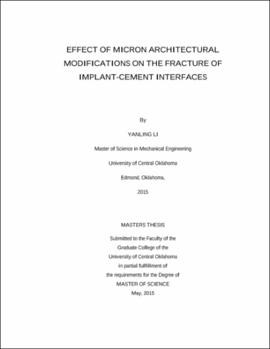| dc.contributor.advisor | Khandaker, Morshed | |
| dc.contributor.author | Li, Yanling | |
| dc.date.accessioned | 2020-07-13T18:32:01Z | |
| dc.date.available | 2020-07-13T18:32:01Z | |
| dc.date.issued | 2015 | |
| dc.identifier.other | (AlmaMMSId)9982402384802196 | |
| dc.identifier.uri | https://hdl.handle.net/11244/325214 | |
| dc.description.abstract | The majority of cemented hip replacements fail due to implant loosening. One design feature that may affect loosening rates is the fracture performance of implant-cement interface. The goal of the study is to develop an effective solution for cemented fixation. It is hypothesis that adding the micron or nano-size bioactive particles or monomer into the cement mantle or coating the micron fibers onto the implant surface can increase the mechanical interlock of the implant-cement interface and eventually solve the implant loosening problem. For cement mantle, bioactive particles (MgO, hydroxyapatite (HAp), chitin (CT), chitosan (CS), Barium sulfate (BaSO4) and Silica (SiO2)) were mixed with polymethylmethacrylate (PMMA) beads and Glycidyl methacrylate (GMA) was added into MMA monomer to prepare various bone cement specimens for improving the conventional PMMA cement mechanical thermal and biological properties. This study found that with GMA, PMMA bone cement without any particle additives has the greatest flexural strength and fracture toughness. Without GMA, SiO2 can significantly increase the fracture toughness and flexural strength of PMMA bone cement. This study has also found that the fracture toughness of bone-PMMA with micro MgO particles and nano MgO particles interfaces were significantly higher comparing to the result of the bone-PMMA interface. For Titanium (Ti) implant, in vitro static test has been performed on implant-cement interface with fiber coated to evaluate the effect of fiber architecture on the fracture strength of Ti-cement interfaces. It has been manifested that either heating up Titanium before coating PCL-acetone fiber or directly coating PCL-PMMA-acetone fiber on the Titanium surface can greatly gain larger fracture strength than cement-Ti without fiber. Additionally, static/fatigue test gripper for the fracture test of implant-cement interface have been designed and analyzed by experiment and ANSYS. It has been manifested that due to the elastic property of the plastic, plastic cement holder can only be used for static test not for fatigue test. Multiple fatigue test gripper have been designed and tried in experiment, which can be used for future fatigue experiments of any bi-material samples. | |
| dc.rights | All rights reserved by the author, who has granted UCO Chambers Library the non-exclusive right to share this material in its online repositories. Contact UCO Chambers Library's Digital Initiatives Working Group at diwg@uco.edu for the permission policy on the use, reproduction or distribution of this material. | |
| dc.subject.lcsh | Biomechanics | |
| dc.subject.lcsh | Artificial hip joints | |
| dc.title | Effect of micron architectural modifications on the fracture of implant-cement interfaces. | |
| dc.type | Academic theses | |
| dc.contributor.committeeMember | Hossan, Mohammad | |
| dc.contributor.committeeMember | Moussa, Abdellah Ait | |
| dc.thesis.degree | M.S., Mechanical Engineering | |
| dc.subject.keywords | Bone-cement interface | |
| dc.subject.keywords | Cemented fixation | |
| dc.subject.keywords | Fracture | |
| dc.subject.keywords | Joint implant | |
| dc.subject.keywords | Ti-cement interface | |
| dc.identifier.oclc | (OCoLC)ocn927150912 | |
| uco.group | UCO - Graduate Works and Theses::UCO - Theses | |
| thesis.degree.grantor | Jackson College of Graduate Studies | |
